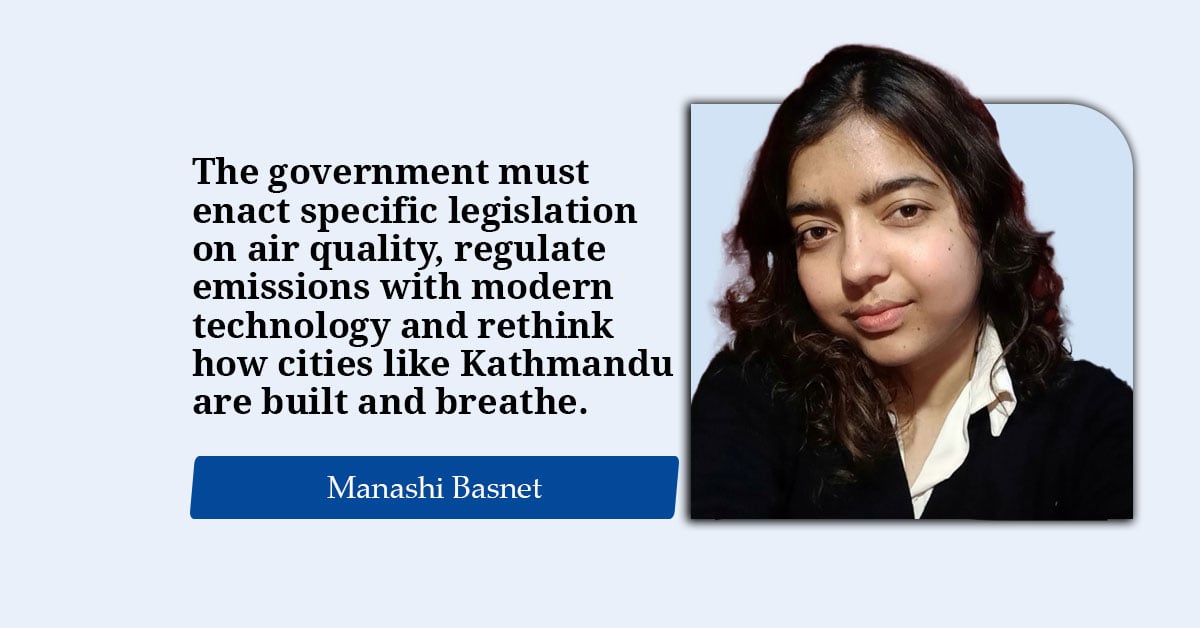

KATHMANDU: For weeks in April, Kathmandu topped the list as the most polluted city in the world. The air quality was so bad that it crossed dangerous levels almost daily, threatening the health of everyone — from children and the elderly to perfectly healthy adults.
The government’s response? Mostly silence, with a few temporary fixes that failed to address the real problem.
Meanwhile, the air gets thicker, our lungs get weaker and the crisis deepens. The health consequences are far from abstract. Long-term exposure to air pollution can lead to serious health issues like asthma, lung cancer and heart diseases. Plus, the daily spikes in pollution can cause breathing problems, lead to eye issues and even result in premature death.
Recent data from the International Centre for Integrated Mountain Development (ICIMOD) reveals a worrying rise in carbon monoxide levels in the valley’s air, which is a colorless, odorless gas that directly interferes with the body’s oxygen supply, posing a serious threat to human health. And this is not just Kathmandu’s problem. AQI readings now show that several regions across Nepal’s south and east have also slipped into “unhealthy” zones, suggesting a looming nationwide crisis unless urgent action is taken
Why is it bad?
Kathmandu suffers from unchecked industrial emissions, poorly regulated construction practices, a lack of emission standards and an overwhelming number of old, polluting vehicles on its congested roads. Despite the alarming data, the government’s solutions have been reactionary at best.
The latest “response” involved proposing odd-even driving days and Sunday holidays, which are just some quick fixes that completely overlook the structural inputs of pollution.
Meanwhile, crucial resources go unused or are mismanaged. As per a news article dated April 7, 2025, a staggering Rs. 25.29 billion collected by the Kathmandu Metropolitan City under the “pollution fee fund” has not been directly allocated to the Ministry of Forests and Environment. The fund appears either misused or unaccounted for, with no transparent plan for implementation or impact. This isn’t just inefficiency, it’s a betrayal of public trust.
A right on paper, not in air
Article 30 of the Constitution of Nepal guarantees every citizen the right to a clean and healthy environment. Yet, this fundamental right has been pushed aside in policy making and enforcement. To date, no air pollution-specific legislation exists in the country. The Environment Protection Act, 2076 (2019) provides a general framework, but lacks mechanisms for regulating urban air quality or punishing violators. Without clear laws and institutional accountability, the air we breathe remains dangerously neglected
Part of the reason Article 30 is so easily sidelined lies in Nepal’s focus on food and economic poverty, which often leads decision-makers to see environmental protection as a “luxury” issue. But in reality, clean air, health and sustainable development are not separate but deeply interconnected.
One cannot claim to fight poverty while ignoring public health. Prioritizing one while neglecting the others is like patching a leak while the boat continues to sink.
What’s needed now is urgent and integrated reform. The government must enact specific legislation on air quality, regulate emissions with modern technology and rethink how cities like Kathmandu are built and breathe. A concrete step forward would be to subsidize or provide free emission filters to heavy and public vehicles, a small fiscal cost that could bring immense public health benefits.
But beyond government action, citizens must also rise, be it by demanding accountability, staying informed or simply speaking up since silence is no longer an option. Breathing clean air isn’t a luxury — it’s a fundamental right we’ve already been guaranteed.
(Manashi Basnet is a third-year BALLB student).